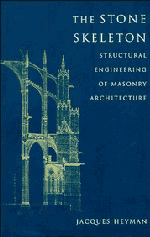6 - Towers and Bells
Published online by Cambridge University Press: 05 August 2014
Summary
The title of this chapter is that of a Handbook (Frost 1990) compiled by the Towers and Belfries Committee of the Central Council of Church Bell Ringers. The Handbook concentrates of course on matters related to bells, but it is also an invaluable source of information regarding the structure and maintenance of masonry towers. Naturally enough, it does not discuss the kind of large-scale disaster referred to in Chapter 2 – the overall collapse of towers such as those at Winchester, Gloucester or Worcester, or the hasty insertion of props at Wells. These disasters occurred within the soil-mechanics time scale for consolidation, of up to twenty years (although, as has been noted, some towers have survived for much longer periods before mysteriously collapsing). It seems evident that settlement of foundations leading to tilt may be a cause of potential danger for a tower; many do, in fact, survive the original high-risk period in which settlement occurs, and appear to survive at alarming angles of inclination (the eye is sensitive to very small deviations from the vertical). Perhaps the most famous example is the campanile of Pisa, but there are many others in Italy, particularly in Venice and in the islands of the lagoon.
- Type
- Chapter
- Information
- The Stone SkeletonStructural Engineering of Masonry Architecture, pp. 109 - 126Publisher: Cambridge University PressPrint publication year: 1995



